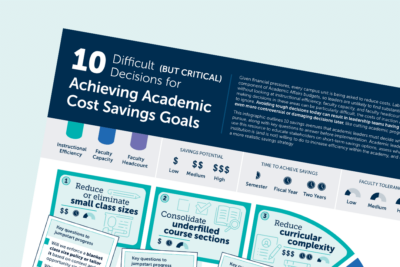Academic leaders are faced with tough decisions each day. And as the higher education landscape continuously transforms, it’s never been more important for leaders to have data to support these types of decisions. The Academic Performance Solutions (APS) platform helps leaders make data-informed decisions by providing insight into current resource use and opportunities to better support students and faculty.
Salisbury University (SU), who has partnered with APS since 2015, has used the platform to “drive the discussion towards data”; from pinpointing courses in which students are struggling to rightsizing section offerings and more. Dr. Richard Wilkens, Associate Provost at SU, spoke with us about how he has led SU’s initiative to create a data-informed culture.
Katerina Chan (KC): What do you believe were some of the key ingredients to your early success in getting data into the hands of key decision-makers?
Richard Wilkens (RW): Thinking back to our early days of implementation, there were some important steps we took that I believe contributed to our success:
Engage key stakeholders as stewards of data quality: It took us time—as well as many stakeholders—to improve the integrity of our data: From HR, from IT, from the registrar, to name a few. Sometimes that meant that our coding system was incorrect for a course type or faculty class and it had to be fixed. It was very important to enlist all users as data quality sleuths; and since those early days of implementation, we continue to think carefully about how we maintain the integrity of our data.
Identify a champion that will support users: We didn’t expect the campus community to simply start using APS because it existed. As Associate Provost, I played an active role in encouraging adoption among key users. In recent months I have:
- Partnered with the dean of the math department on a D grade, failing, or withdrawing (DFW) rate analysis for Calculus courses
- Collaborated with Administration and Finance to construct a department-level cost/revenue analysis, which has proved a useful tool in strategic planning
- Showed the philosophy chair how to use intercurricular dependencies to find the best places for his department to strengthen cooperation with other disciplines
- Met with leaders from the academic advising center on using APS to evaluate DFW rates, which can be useful information for creating an advising strategy
I have established myself as the go-to resource when anyone on campus believes that APS might be useful to them. I believe that having a go-to leader is essential in the transition from start up to wide-scale adoption.
Promote routine utilization: My current goal is to increase the number of successful use cases we have by implementing a routine APS process for departments or other units across campus. For example, I’ve been using EAB resources to develop an annual departmental review process. Moreover, SU is instituting a more decentralized budgeting process and we will promote APS as a tool for proposing budgets to deans and the provost.
KC: Many members use APS to target improvements in course completion rates. Can you share how the SU math department addressed high DFW rates with APS?
RW: The math department noted an upward drift in DFW rates. Using APS, we could easily visualize this trend and see that the shift appeared to be across all sections—which implied to us a shift in student preparedness. The math department instituted several curricular changes to Calculus I, such as a mandatory extra hour of class time devoted to math fundamentals and some additional testing metrics. Though early, DFW rates dropped from 48.9% in Fall 2017 to 38.8% in Fall 2018 for Calc I! This may be one of the best examples of how APS can inform decisions leading to greater student success as well as section efficiency.
Related: It matters who is teaching your 101 classes—and how
KC: That’s a great example. Are there other early wins that have helped generate momentum for that wider scale adoption you are seeking?
RW: The biology chair used APS to analyze why upper-level biology courses were under-enrolled. He quickly discovered through the platform that, for unknown reasons, biology had been offering an additional section of upper-level biology each semester. Since then, biology has not had an upper-level enrollment problem. These kinds of one-off victories are important in the transition to more wide-scale usage because our deans and chairs were discovering value so early on in their use of their platform. We also continue to re-examine policies such as our max caps and how we classify faculty ranks to keep the quality of our data strong.
KC: Being a member of the APS collaborative offers more than just a platform. Can you describe what role your dedicated consultant plays in supporting the work you’re carrying out at Salisbury?
RW: I would like to offer a shout out to SU’s dedicated consultant, Harrison Greer, who has been outstanding for SU! We talk weekly and have formed a partnership in which we develop implementation strategy, technical review of data integrity, and training approaches. Harrison has also been a sounding board and liaison to EAB tech staff about many of my observations and ideas about how I think APS could be an even better product. It has been quite satisfying to see many of our conversations about possible improvements to APS turn into action by EAB. In general, touching base frequently with Harrison has helped the success of APS at SU.
KC: As you reflect on your early intentions for becoming a more data-informed culture, how has the perception of data transformed on Salisbury’s campus?
RW: There is now a general expectation that data be included in any proposal where it is relevant. I believe that this expectation, though not exclusively driven by APS availability, has been deeply enhanced by its existence. Perception has transformed from data is good, to data is necessary, to data is expected. We use data to inform and help us develop strategy.
See how APS helped Salisbury University power data-informed decisions
Download our case study to discover how Academic Performance Solutions enabled Salisbury University to put cost data into the hands of department chairs and establish a policy for setting maximum capacity across all colleges.


